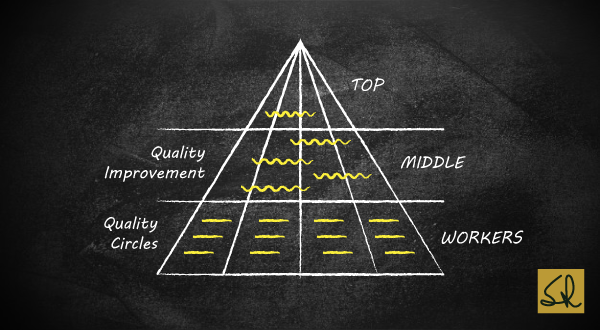STRUCTURED QUALITY IMPROVEMENT

Lessons Learned in Quality Capsules 1 to 4
Quality Capsule 1: What is Quality?
Quality is fitness for use.
This basic definition branches into two arms:
1. Quality = Product features that meet customer needs
2. Quality = Freedom from deficiencies along the entire supply chain
Quality Capsule 2: How to Manage for Quality?
Managing for Quality is accomplished by using the Juran Trilogy:
▪ Quality Planning
▪ Quality Control
▪ Quality Improvement.
Quality Capsule 3: Quality Improvement
A sporadic quality problem is a sudden adverse change in the status quo. This is quality control.
A chronic quality problem is a long-standing adverse situation, which requires remedy through changing the status quo. This is quality improvement.
Quality Capsule 4: How to Assess COPQ
COPQ can be decomposed into four categories:
- Internal Failure Costs: These are costs associated with defects (errors, non-conformance, etc) that are detected prior to the transfer of the product / service to the customer.
- External Failure Costs: These are costs associated with defects that are found after the product / service is delivered to the customer.
- Appraisal Costs: These are costs incurred in determining the degree of conformance to quality requirements.
- Prevention Costs: These are costs incurred in keeping failure and appraisal costs to a minimum.
Quality Improvement vs Quality Circles
I believe: Quality Improvement should be included in job design and the performance appraisal system.
How often have you observed quality improvement project teams using the same methodology as being used for quality circles?
Here are a few insights:
- The primary objective of a quality circle program is motivation. The secondary is quality improvement.
- The primary objective for a CQI program is quality improvement. The secondary is motivation.
- In quality circles, the team selects the problem.
- In CQI, the problem selects the team.
- Quality circle teams are voluntary within departments.
- Quality improvement project teams are cross-functional and appointed by the top management.
- Quality circles tend to focus on seven quality tools.
- Quality improvement project teams have a library of 40 quality tools that they use in multiple combinations.
Quality Improvement Methodology
Chronic problems can be solved using a structured quality improvement methodology.
There are four key steps in the quality improvement methodology:
1. Problem Definition
2. Problem Diagnosis
3. Problem Remedy
4. Locking the Improvement.
The most critical step is the first step, namely, Problem Definition. This is the responsibility of top management / quality council.
A good problem statement should:
▪ Indicate the quantum of COPQ that can be reduced
▪ Be specific, observable and measurable
▪ Be of a size that is manageable by a team in a few months.
A good problem statement should not:
▪ Imply blame
▪ Indicate a root cause
▪ Suggest a solution.
I will discuss the remaining three steps in my next blog on Wednesday, 12 August.
Now, refer to the question I had asked last week in Quality Capsule 4: What is the effect of COPQ on break-even point?
My response is: Break-even point can be defined as a point where total costs (expenses) and total sales (revenue) are equal. Total costs are a sum of fixed costs and variable costs. The greater the fixed costs, the higher the break-even point. COPQ is cemented in fixed costs!
My question to you this week is: What are the quality tools that top management must know?
Additional Reference:
Certified Quality Improvement Associate: Primer & Solution Text, Quality Council of Indiana.
To order, please follow https://www.qimpro.com/store/CQIA/p

1. Decision trees
2. Pareto Analysis
Also, Flow Diagram
Quality improvement is a top to bottom apoorach.Top management decides the approach and CFT team are formed based upon the problem .
Top management must know the tools like OEE, COPQ .
Flow Charting
Pareto Analysis
Both facilitate COPQ estimation and project prioritization..
Sir ,
Didn’t Dr. Juran say that the team should be not only cross-functional but also cross-hierarchical ? He christened it the Quality Council . The Quality Circle is within the same function and hierarchy .
Also , the improvement (organised creation of beneficial change) can be reactive (problem solving) or proactive (continuous improvement) . Reactive improvement has its trigger from the outside of the place of action or relevance , Proactive improvement has its trigger at the place of action or relevance .
Just my two pence .
Operationally, you are right.!!!!
Strategically, I am right!!!!!